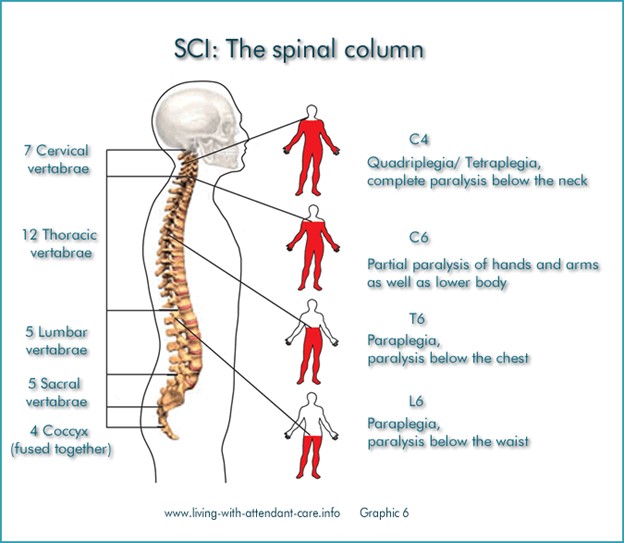A nurse is caring for a client who has a complete spinal cord injury. Based on the nurse's understanding about the degree of this type of injury, what can the nurse expect will be the client's level of function?
The client will need 24-hour a day care.
The client will be able to assist with transfer and perform self-care.
The client will be able to roll over independently.
The client will be able to drive an electric wheelchair.
The Correct Answer is A
Choice A Reason: This is the correct choice because a complete spinal cord injury is a condition where there is no motor or sensory function below the level of injury. The client will have paralysis of all four limbs (quadriplegia) and loss of bladder, bowel, and sexual function. The client will also have impaired thermoregulation, breathing, and blood pressure. The client will need 24-hour a day care to assist with mobility, hygiene, elimination, nutrition, and prevention of complications.
Choice B) Reason: This is incorrect because a client who is able to assist with transfer and perform self-care has a partial spinal cord injury, not a complete one. A partial spinal cord injury is a condition where there is some motor or sensory function below the level of injury. The degree of impairment depends on the extent and location of the damage.
Choice C Reason: This is incorrect because a client who is able to roll over independently has a lower spinal cord injury, not a complete one. A lower spinal cord injury is a condition where there is damage to the lumbar or sacral segments of the spinal cord. The client will have paralysis of the lower limbs (paraplegia) and some loss of bladder, bowel, and sexual function. The client will still have some control over the upper limbs and trunk.
Choice D Reason: This is incorrect because a client who is able to drive an electric wheelchair has an upper spinal cord injury, not a complete one. An upper spinal cord injury is a condition where there is damage to the cervical or thoracic segments of the spinal cord. The client will have paralysis of all four limbs (quadriplegia) and loss of bladder, bowel, and sexual function. However, the client may still have some movement or sensation in the shoulders, arms, or hands.

Nursing Test Bank
Naxlex Comprehensive Predictor Exams
Related Questions
Correct Answer is B
Explanation
Choice A Reason: Depth perception is the ability to judge the distance and position of objects in three-dimensional space. Depth perception is assessed by asking the client to touch the tip of a pen or pencil held by the nurse, or by using a stereopsis test.
Choice B Reason: Peripheral vision is the ability to see objects and movements outside the direct line of vision. Peripheral vision is assessed by asking the client to shake the hand of the nurse, who stands at an angle to the client's side, or by using a confrontation test.
Choice C Reason: Color deficit is the inability to distinguish certain colors or shades of colors. Color deficit is assessed by asking the client to identify numbers or shapes on a color plate test, such as the Ishihara test.
Choice D Reason: Double vision is the perception of two images of a single object. Double vision is assessed by asking the client to cover one eye and look at an object, then switch eyes and compare the images, or by using a cover-uncover test.
Correct Answer is B
Explanation
Choice A Reason: The test is not inconclusive, but rather positive for conductive hearing loss. The Weber test involves placing a vibrating tuning fork on the center of the forehead and asking the client which ear hears the sound louder. It can help differentiate between conductive and sensorineural hearing loss.
Choice B Reason: This is the correct choice. The client has conductive hearing loss, which is a type of hearing loss that occurs when sound waves are blocked or reduced in the outer or middle ear. It can be caused by earwax, infection, fluid, perforation, or trauma. In conductive hearing loss, the Weber test shows lateralization to the affected ear, meaning the sound is heard louder in that ear.
Choice C Reason: The client does not have normal hearing, but rather conductive hearing loss. In normal hearing, the Weber test shows no lateralization, meaning the sound is heard equally in both ears.
Choice D Reason: The client does not have sensorineural hearing loss, but rather conductive hearing loss. Sensorineural hearing loss is a type of hearing loss that occurs when there is damage to the inner ear or auditory nerve. It can be caused by aging, noise exposure, disease, or drugs. In sensorineural hearing loss, the Weber test shows lateralization to the unaffected ear, meaning the sound is heard louder in that ear.
Whether you are a student looking to ace your exams or a practicing nurse seeking to enhance your expertise , our nursing education contents will empower you with the confidence and competence to make a difference in the lives of patients and become a respected leader in the healthcare field.
Visit Naxlex, invest in your future and unlock endless possibilities with our unparalleled nursing education contents today
Report Wrong Answer on the Current Question
Do you disagree with the answer? If yes, what is your expected answer? Explain.
Kindly be descriptive with the issue you are facing.
